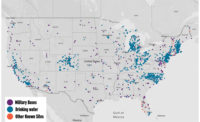The U.S. Environmental Protection Agency’s new action plan to address a group of toxins known as PFAS is “disappointing” and “drawn out,” and leaves millions exposed to harmful chemicals, according to environmental officials in New Jersey, which has taken the lead to develop limits for them.
“While some EPA action is encouraging, New Jersey cannot wait for the federal government to address the risks posed by these chemicals,”the state Dept. of Environmental Protection said in a statement.
EPA has a health advisory of 70 parts per trillion for the chemicals in drinking water, which the Agency for Toxic Substances and Disease Registry suggested last year was far too weak based on its finding of adverse health outcomes from exposure. The chemicals were used, beginning in the 1950s, in nonstick cookware, flame retardant fabrics and firefighting foam, but are no longer produced in the U.S.
The EPA announced Feb. 14 it would formally decide by the end of the year whether it should begin developing a national primary drinking water regulation for the two leading PFAS chemicals—perfluorooctanoic acid (PFOA) and perfluorooctane sulfonate (PFOS).
The agency says it will develop, this year, interim cleanup recommendations to address groundwater contaminated with PFOA and PFOS.
But EPA says it won't determine until 2021 if data and research support development of ambient water quality criteria for human health for PFAS chemicals,
It has also initiated the regulatory development process for listing PFOA and PFOS as Superfund hazardous substances, but called the process “ongoing” and did not give an anticipated date for completion.
“This process will provide regulatory certainty, while ensuring the legal defensibility of EPA’s regulatory actions,” an EPA spokesman said.
But New Jersey sees the federal plan differently. “The Trump administration is leaving millions of Americans exposed to harmful chemicals for too long by choosing a drawn-out process that will delay establishing a federal maximum contaminant level for PFAS,” the state DEP said.
In September, New Jersey established a maximum contaminant level for perfluorononanoic acid or PFNA. It is currently accepting public comments on interim rules for cleanup of groundwater contaminated with PFOA and PFOS.
Pennsylvania also has begun developing limits on PFOA and PFOS. “The people of Pennsylvania cannot wait on the federal government,” a spokesman for the state’s Dept. of Environmental Protection said.
The chemicals, known to be on 172 contaminated sites in 40 states that could affect 1,500 drinking water systems, are considered to be highly toxic, have been linked to some cancers in humans and can lead to liver damage, thyroid dysfunction, metabolic and immune system problems and increased bad cholesterol levels.
The compounds are resistant to biodegradation and are persistent in soil and water and leach into the groundwater, according to the Agency for Toxic Substances and Disease Registry’s 852-page report released last year.





Post a comment to this article
Report Abusive Comment